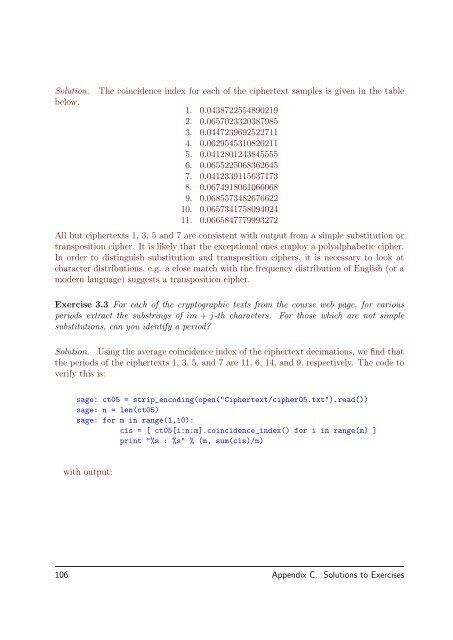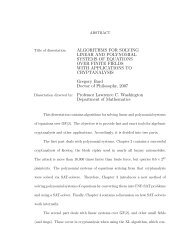sage: (r,s) = (7,5)sage: G = SymmetricGroup(r*s)sage: S = [ i+s*j for i in range(1,s+1) for j in range(r) ]sage: G(S)(2,6,26,24,14,32,20,28,34,30,10,12,22,4,16,8)(3,11,17,13,27,29,5,21,33,25,19,23,9,7,31,15)Elementary CryptanalysisOne important measure of a cryptographic text is the coincidence index. For random text(of uniformly distributed characters) in an alphabet of size 26, the coincidence index isapproximately 0.0385. For English text, this value is closer to 0.0661. Therefore we shouldbe able to pick out text which is a simple substitution or a transposition of English text,since the a coincidence index remains unchanged.The SAGE crypto string functionscoincidence index and frequency distributionprovide functionality for analysis of the ciphertexts in the exercises. Moreover, for a SAGEstring s the k-th decimation of period m for that string is given by s[k::m] (short fors[k:len(s):m]).Exercise 3.1 Complete the deciphering of the Vigenère ciphertext of Section 3.3 . Whatdo you note about the relation between the text and the enciphering or deciphering key? Auseful tool for this task could be the following javascript application for analyzing Vigenèreciphers:http://echidna.maths.usyd.edu.au/ kohel/tch/Crypto/vigenere.htmlConsider those ciphertexts from previous exercises which come from a Vigenère cipher, anddetermine the periods and keys for each of the ciphertext samples.Exercise 3.2 For each of the cryptographic texts from the course web page, compute thecoincidence index of the ciphertexts. Can you tell which come from simple substitution ortransposition ciphers? How could you distinguish the two?105
Solution.below.The coincidence index for each of the ciphertext samples is given in the table1. 0.04387225548902192. 0.06570233203879853. 0.04472396925227114. 0.06295453108202115. 0.04128012438455556. 0.06552250683626457. 0.04123391156371738. 0.06749180610660689. 0.068557348267662210. 0.065734175809402411. 0.0665847779993272All but ciphertexts 1, 3, 5 and 7 are consistent with output from a simple substitution ortransposition cipher. It is likely that the exceptional ones employ a polyalphabetic cipher.In order to distinguish substitution and transposition ciphers, it is necessary to look atcharacter distributions, e.g. a close match with the frequency distribution of English (or amodern language) suggests a transposition cipher.Exercise 3.3 For each of the cryptographic texts from the course web page, for variousperiods extract the substrings of im + j-th characters. For those which are not simplesubstitutions, can you identify a period?Solution. Using the average coincidence index of the ciphertext decimations, we find thatthe periods of the ciphertexts 1, 3, 5, and 7 are 11, 6, 14, and 9, respectively. The code toverify this is:sage: ct05 = strip_encoding(open("Ciphertext/cipher05.txt").read())sage: n = len(ct05)sage: for m in range(1,10):cis = [ ct05[i:n:m].coincidence_index() for i in range(m) ]print "%s : %s" % (m, sum(cis)/m)with output:106 Appendix C. Solutions to Exercises
- Page 1 and 2:
Author (David R. Kohel) /Title (Cry
- Page 4 and 5:
CONTENTS1 Introduction to Cryptogra
- Page 6:
PrefaceWhen embarking on a project
- Page 10 and 11:
information. We introduce here some
- Page 12 and 13:
ut strings in A ∗ map injectively
- Page 14 and 15:
CHAPTERTWOClassical Cryptography2.1
- Page 16 and 17:
LV MJ CW XP QO IG EZ NB YH UA DS RK
- Page 18 and 19:
As a special case, consider 2-chara
- Page 20 and 21:
Note that if d k = 1, then we omit
- Page 22:
ExercisesSubstitution ciphersExerci
- Page 25 and 26:
Ciphertext-only AttackThe cryptanal
- Page 27 and 28:
of size n, suppose that p i is the
- Page 29 and 30:
Note that ZKZ and KZA are substring
- Page 31:
Checking possible keys, the partial
- Page 34 and 35:
sage: X = pt.frequency_distribution
- Page 36 and 37:
CHAPTERFOURInformation TheoryInform
- Page 38 and 39:
For each of these we can extend our
- Page 40 and 41:
in terms of the cryptosystem), then
- Page 42 and 43:
CHAPTERFIVEBlock CiphersData Encryp
- Page 44 and 45:
Deciphering. Suppose we begin with
- Page 46 and 47:
The Advanced Encryption Standard al
- Page 48 and 49:
1. Malicious substitution of a ciph
- Page 50 and 51:
locks M j−1 , . . . , M 1 as well
- Page 52:
where X = K ⊕ M = (X 1 , X 2 , X
- Page 55 and 56:
6.2 Properties of Stream CiphersSyn
- Page 57 and 58:
Exercise. Verify that the equality
- Page 59 and 60: n 2 n − 11 12 33 74 155 316 637 1
- Page 61 and 62: Exercise 6.6 In the previous exerci
- Page 63 and 64: Exercise 6.9 Compute the first 8 te
- Page 65 and 66: which holds since −4 = 17 + (−1
- Page 67 and 68: must therefore have a divisor of de
- Page 69 and 70: Shrinking Generator cryptosystemLet
- Page 72 and 73: CHAPTEREIGHTPublic Key Cryptography
- Page 74 and 75: Initial setup:1. Alice and Bob publ
- Page 76 and 77: We apply this rule in the RSA algor
- Page 78 and 79: the discrete logarithm problem (DLP
- Page 80 and 81: Man in the Middle AttackThe man-in-
- Page 82: Exercise 8.6 Fermat’s little theo
- Page 85 and 86: k < p − 1 with GCD(k, p − 1) =
- Page 88 and 89: CHAPTERTENSecret SharingA secret sh
- Page 90: using any t shares (x 1 , y 1 ), .
- Page 93 and 94: sage-------------------------------
- Page 95 and 96: sage: x.is_unit?Type:builtin_functi
- Page 97 and 98: Python (hence SAGE) has useful data
- Page 99 and 100: sage: n = 12sage: for i in range(n)
- Page 101 and 102: sage: I = [55+i for i in range(3)]
- Page 103 and 104: sage: I = [7, 4, 11, 11, 14, 22, 14
- Page 105 and 106: ExercisesRead over the above SAGE t
- Page 107 and 108: 102
- Page 109: Solution. The block length is the n
- Page 113 and 114: analysis of the each of the decimat
- Page 115 and 116: arbitrary permutation of the alphab
- Page 117 and 118: In order to understand naturally oc
- Page 119 and 120: We do this by first verifying the e
- Page 121 and 122: Solution.None provided.Linear feedb
- Page 123 and 124: Multiplying each through by the con
- Page 125 and 126: Solution. The linear complexity of
- Page 127 and 128: If a, b, and c are as above, then f
- Page 129 and 130: Exercise 8.5 Use SAGE to find a lar
- Page 131 and 132: Solution. Now we can verify that e
- Page 133 and 134: which has no common factors with p
- Page 135 and 136: sage: p = 2^32+61sage: m = (p-1).qu
- Page 137 and 138: sage: a5 := a^n5sage: c5 := c^n5sag
- Page 139 and 140: The application of this function E
- Page 141 and 142: 5. (∗) How many elements a of G h
- Page 143: 1. The value f(0) of the polynomial
















